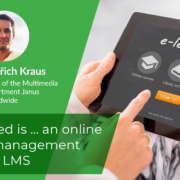E-learning and learning management
Oldřich Kraus
Learning is something we all do throughout our lives. The more advanced our civilization becomes, the greater our need to learn. It therefore stands to reason that there is great benefit in learning as effectively as possible—and that’s where e-learning comes in.
Imagine you run a multinational company with employees all over the world. You have a regular need to teach every single employee something, and this could also include sharing all kinds of information, such as certain company policies, initial job orientation, various health and safety protocols, instructions on how to use company’s accounting system, HR processes, and so on and so forth. The list is endless.
How might you approach this critical task? Some companies might send training teams out to all their branches, train other trainers to deliver the content in different languages and/or prepare all materials with full instructions and disseminate them to their employees. But even if such companies manage to prepare all the instructions in electronic form, perhaps including nice slide decks with images and videos, and localize them into the various languages used in their organization, they would still need to somehow manage and verify the training, a responsibility that will likely fall to the assigned trainers (or simply to more senior employees).
What you really want in this situation is an online learning management system, or LMS. And in it, you want to have your training materials in the form of a standard e-learning course, which is a presentation that is accessible online and features slides containing all the relevant information. It should make use of audiovisual elements, such as narration by an instructor, and possibly include some instructional videos. In short, anything that will facilitate effective multisensory learning. And don’t forget the most important part: an interactive test (or quiz) to confirm that learners have assimilated the knowledge.
This will give you an accurate overview of the state of knowledge in your company. All of your employees will have an LMS account in which all the applicable courses have been assigned to them. You and they will have a real-time overview of their progress across all the courses, so that you can see which ones have been failed, where attention needs to be focused, and so on. In other words, you will have a very clear idea of who knows what. This, is in my opinion, is the greatest benefit offered by an LMS, in addition to the obvious advantages like cost savings, consistency of learning and access to educational materials. Having an overview of what each employee knows and the ability to identify and quickly fill any gaps is truly priceless.
E-learning will be only as good as the quality of the individual training materials (courses). Once you have those, the only question remaining is how to approach the process of localizing the courses into different languages. Naturally, it makes no sense to create a course from scratch in each language, and you will want to ensure that the localized courses are consistent with your original materials.
That’s where Janus comes in. Whatever your course looks like—whether it’s a nice presentation with animation and voice-over, perhaps a video from a classroom, or just a simple html5—Janus will take it, disassemble it, translate all required components (including recording the voice-over in the target language) and rebuild it in any language you need.


 Head of the Multimedia department
Head of the Multimedia department



